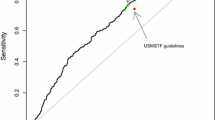Abstract
Background
Malignant colorectal polyps (MCRP) have become a major challenge in the field of coloproctology from diagnosis to full treatment. One important facet of the challenge is the histopathological staging of the lesion and identifying various prognostic parameters. The primary aim of this study was to find the interobserver variation amongst 4 experienced gastrointestinal pathologists when assessing important parameters and staging systems (Haggitt, Kikuchi and Ueno) in MCRPs.
Methods
Four experienced gastrointestinal pathologists independently assessed 56 cases of MCRP, and each pathologist completed a pro forma for each case. The results were collated and statistically analysed.
Results
There was a significant variation in the assessments using the various published staging systems agreed upon on important prognostic parameters.
Conclusions
None of the staging systems used is suitable for all polyp types or has good reproducibility. There is an urgent need to make pathologists’ assessment of MCRPs easier and more reproducible.

Similar content being viewed by others
References
Williams JG, Pullan RD, Hill J et al (2013) Management of the malignant colorectal polyp: ACPGBI position statement. Colorectal Dis 15(Suppl 2):1–38
Bosman FT (2010) World Health Organization, International Agency for Research on Cancer. WHO classification of tumours of the digestive system. World Health Organization classification of tumours, vol 3, 4th edn. International Agency for Research on Cancer, Lyon
Vieth M, Quirke P, Lambert R, von Karsa L, Risio M (2012) European guidelines for quality assurance in colorectal cancer screening and diagnosis, 1st edn–Annotations of colorectal lesions. Endoscopy 44 Suppl 3:SE131–SE139
Ueno H, Murphy J, Jass JR, Mochizuki H, Talbot IC (2002) Tumour ‘budding’ as an index to estimate the potential of aggressiveness in rectal cancer. Histopathology 40:127–132
Ueno H, Mochizuki H, Hashiguchi Y et al (2004) Risk factors for an adverse outcome in early invasive colorectal carcinoma. Gastroenterology 127:385–394
Kikuchi R, Takano M, Takagi K et al (1995) Management of early invasive colorectal cancer. Risk of recurrence and clinical guidelines. Dis Colon Rectum 38:1286–1295
Haggitt RC, Glotzbach RE, Soffer EE, Wruble LD (1985) Prognostic factors in colorectal carcinomas arising in adenomas: implications for lesions removed by endoscopic polypectomy. Gastroenterology 89:328–336
Kudo S (1993) Endoscopic mucosal resection of flat and depressed types of early colorectal cancer. Endoscopy 25:455–461
Landis JR, Koch GG (1977) The measurement of observer agreement for categorical data. Biometrics 33:159–174
Kitajima K, Fujimori T, Fujii S et al (2004) Correlations between lymph node metastasis and depth of submucosal invasion in submucosal invasive colorectal carcinoma: a Japanese collaborative study. J Gastroenterol 39:534–543
Komuta K, Batts K, Jessurun J et al (2004) Interobserver variability in the pathological assessment of malignant colorectal polyps. Br J Surg 91:1479–1484
Loughrey B, Quirke P, Shepherd N (2014) RCPath Standards and datasets for reporting cancers: Dataset for colorectal cancer histopathology reports. RCPath. http://www.rcpath.org/publications-media/publications/datasets/colorectal-cancer.htm. Accessed 11 May 2015
Ramirez M, Schierling S, Papaconstantinou HT, Thomas JS (2008) Management of the malignant polyp. Clin Colon Rectal Surg 21:286–290
Zinicola R, Hill J, Fiocca R (2015) Surgery for colorectal polyps: histological features, current indications, critical points, future perspective and ongoing studies. Colorectal Dis 17(Suppl 1):52–60
Quirke P, Risio M, Lambert R, von Karsa L, Vieth M (2012) European guidelines for quality assurance in colorectal cancer screening and diagnosis. 1st edn. Quality assurance in pathology in colorectal cancer screening and diagnosis. Endoscopy 44 Suppl 3:SE116–SE130
Wang LM, Sheahan K (2011) Prognostic markers in colorectal pathology: is morphology enough? Diagn Histopathol 17:386–394
Bujanda L, Cosme A, Gil I, Arenas-Mirave JI (2010) Malignant colorectal polyps. World J Gastroenterol 16:3103–3111
Sohn DK, Chang HJ, Park JW et al (2007) Histopathological risk factors for lymph node metastasis in submucosal invasive colorectal carcinoma of pedunculated or semipedunculated type. J Clin Pathol 60:912–915
Beaton C, Twine CP, Williams GL, Radcliffe AG (2013) Systematic review and meta-analysis of histopathological factors influencing the risk of lymph node metastasis in early colorectal cancer. Colorectal Dis 15:788–797
Mitrovic B, Schaeffer DF, Riddell RH, Kirsch R (2012) Tumor budding in colorectal carcinoma: time to take notice. Mod Pathol 25:1315–1325
Wang LM, Guy R, Fryer E et al (2015) Ueno method substaging pT1 colorectal adenocarcinoma by depth and width measurement: an inter-observer study. Colorectal Dis 17:674–681
Haboubi N, Salmo E (2013) Are we accurately measuring the depth of the submucosal invasion in early colorectal cancer by equating the Kikuchi submucosa levels with distances measured in fractions of a millimetre? Colorectal Dis 15:775–777
Acknowledgments
We would like to acknowledge the help of Helen Carruthers, Medical Illustration, UHSM, for the preparation of Fig. 1.
Author information
Authors and Affiliations
Corresponding author
Ethics declarations
Conflict of interest
The authors declare that they have no conflict of interest.
Ethical approval
This study was exempt from IRB approval.
Informed consent
For this type of study on archival material informed consent is not required.
Rights and permissions
About this article
Cite this article
Davenport, A., Morris, J., Pritchard, S.A. et al. Interobserver variability amongst gastrointestinal pathologists in assessing prognostic parameters of malignant colorectal polyps: a cause for concern. Tech Coloproctol 20, 647–652 (2016). https://doi.org/10.1007/s10151-016-1513-8
Received:
Accepted:
Published:
Issue Date:
DOI: https://doi.org/10.1007/s10151-016-1513-8




